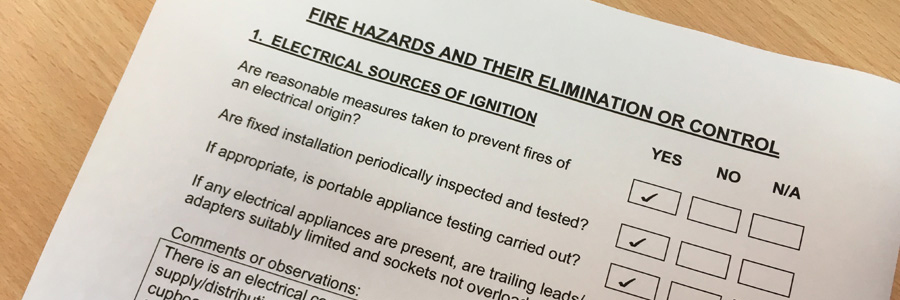
A fire risk assessment takes into consideration the current precautions being made regarding potential fires, and whether or not they are adequate enough. In a fire risk assessment, a simple drawing of a premises is drawn up that highlights a building’s general structure, storage areas, accommodation areas and how they are used. It should identify potential hazards such as combustible equipment/products and those people at risk, alongside action that should be taken. If a fire does occur, it is a good idea to have this drawing to hand to give to the fire service to help them understand a building’s layout. Combustibles are typically circled in red.
Causes of fire
A fire risk assessment will typically identify potential fire hazards and sources of ignition. For a fire to ignite and spread, it requires heat or a flame, and oxygen to fuel its reach. By keeping potential ignition sources and fuel apart, the risk of a fire can be significantly reduced, meaning that risks to people and building structure are also greatly decreased. It is important to identify heat sources and any sources of ignition that could create a fire in a workplace (such as a gas cooker in an office kitchen). Other less obvious risks can be from chemical sources or electrical. Potential fire sources are:
- Faulty electrics such as lighting, wiring, leads and adapters
- Lighters, candles, smoking equipment, and matches
- Sparks and flames from working processes within a workshop such as welding, grinding or cutting
- Heat caused by friction
- Static electricity
- Ovens, microwaves, deep fat fryers and other electrical cooking apparatus
- Equipment that burns oil
- Heaters
- Flammable materials such as paper, wood, cardboard and polyurethane foam
- Flammable liquids such as solvents/paint
- Arson
- Carelessness and lax health and safety procedures, such as employees smoking near flammable materials
- Poor housekeeping
The role of the ‘Responsible Person’
Regarding fire risk assessment, the ‘Responsible Person’ is required by the Fire Safety Order to ensure that appropriate action is taken to minimise fire risks. Typically, the ‘Responsible Person’ is an owner of the property being assessed, or someone in a position of power within the business with a degree of responsibility. The role of the ‘Responsible Person’ is to ensure, on a risk-assessment basis, that the building and its employees are safe at all times and that all fire risks are minimised as much as possible. Their duties also include:
- Identifying fire hazards and removing them
- To establish fire safety procedures to protect employees
- Taking steps to reduce the chances of a fire igniting
- To ensure that all people based within a building leave its premises safely and quickly in the event of a fire via a well-rehearsed fire drill
- Taking action to limit the spread of a fire, should this happen
A Responsible Person can also have an assistant who is well trained in fire hazard/risk-based situations. The Responsible Person does however remain responsible for fire risk assessment at the company and its related procedures at all times. All of the above should be straightforward procedures without additional expense to a company. If however a building does not comply with building regulations and fire hazard procedures are not in place, it is especially important to have a fire risk assessment and instruction from an authoritative body such as RES Fire Protection Engineers, who can advise on building occupancy and potential fire risks.
Identifying hazards
When you have identified fire hazards within a building, you need to take steps to remove them in order to reduce the chance of a fire occurring and spreading. You can do this by:
- Completely removing the hazard (in certain situations)
- Reducing a hazard to the point where risk is minimal
- Replacing the hazard with a safer alternative or moving it to a different location within the premises
- Adhering to a fire safety policy to prevent hazards in future
Areas containing fire hazards are generally low, medium or high risk. Low risk areas often give those nearby enough time to react to them, with minimal risk of ignition. Medium risk areas are most parts of a general building, and high risk areas often carry a great chance of ignition where a fire could spread quickly.
It is important to ensure that a building complies with health and safety regulations and that fire exits and routes of escape are clearly pointed out to those in a building in case of a fire. Consider whether you have enough fire exits and whether they are well lit and unobstructed. Fire fighting equipment such as extinguishers should also be positioned within easy reach and wall mounted close to fire exits. Fire alarms should also be heard by all those within the building, and all staff should be trained in what to do in the event of a fire.
;)
;)
